

e-mail :

This document continues the investigation of special categories (If / Then constants), and compares crystals with organisms.
Crystals and Organisms, Shape, Symmetry and Promorph.
Sequel to the investigation of some (intrinsic) shapes of two-dimensional crystals regarding their relationship to intrinsic point symmetry and promorph.
Bilateral Pentagon
We will now investigate two-dimensional crystals with an intrinsic shape according to a bilateral pentagon as to their possible promorphs, but, as in the foregoing, limiting ourselves to holomorphic crystals, which means that we will only investigate crystals of which their intrinsic symmetry is the same as the symmetry of their intrinsic shape. In the present case this means that our bilaterally pentagonal crystals will have D1 intrinsic symmetry (while in other cases -- meromorphic crystals -- this symmetry could be according to C1 (the Asymmetric Group), depending on the crystal's internal structure).
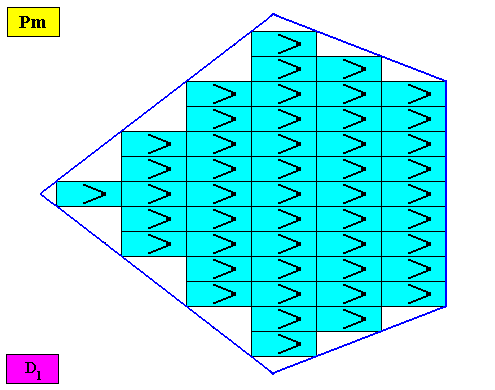
Figure above : Microscopic view of a two-dimensional bilaterally pentagonal D1 crystal consisting of the periodic stacking of rectangular building blocks, provided with D1 motifs (black). These D1 motifs represent the translation-free residue of the crystal (all the same whether it belongs to the plane group Pm, Pg or Cm), and in this example the residue has two antimers. As drawn, the crystal belongs to the plane group Pm (primitive rectangular lattice, pattern of symmetry elements : mirror lines only, all of them of the same type). So the crystal of this example itself has two antimers and is thus non-eupromorphic (because the crystal's intrinsic shape suggests five antimers, while in fact there are only two present). Because the building blocks are in fact very small (i.e. in crystals they have microscopic dimensions), all the crystal faces are macroscopically smooth.
The intrinsic shape of our crystal is that of a bilateral pentagon. The grammatical adjective of the latter would be "bilaterally pentagonal" as in "bilaterally pentagonal crystal" (where "bilaterally" is an adverb). But because such a crystal itself is pentagonal as well as bilateral, we can legitimately use the expression "bilateral pentagonal crystal", which then, as a convenient term, we will use in what follows.
By removing the lattice connection lines (indicating the building blocks) and the motifs, we obtain a macroscopic view of this crystal :
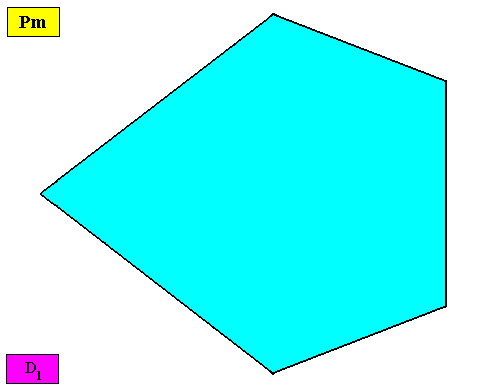
Figure above : Macroscopic view of the bilateral pentagonal crystal of the previous Figure.
The pattern of symmetry elements (with respect to the point symmetry) of our bilateral pentagonal D1 two-dimensional crystal is given in the next Figure.
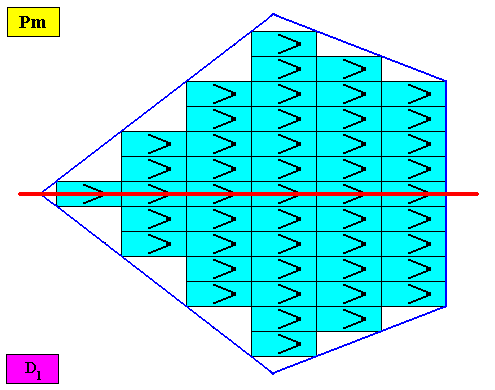
Figure above : Pattern of symmetry elements of the above given bilateral pentagonal D1 two-dimensional crystal. Its consists of one mirror line (red) only.
Three crystallographic Forms are needed to construct the outline of the bilateral pentagonal crystal, as the next Figure shows.
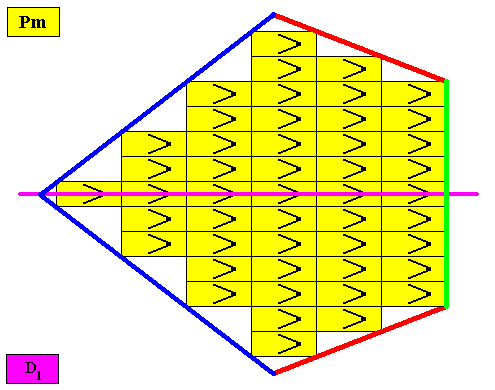
Figure above : Three crystallographic Forms (red, dark blue, green) are needed to construct the faces of our bilateral pentagonal D1 two-dimensional crystal : An initially given oblique face (red, not parallel, neither perpendicular to the mirror line) implies one more face in virtue of the mirror line, resulting in one open Form consisting of two faces (red). In the same way a second initially given face (dark blue) also gives rise to a Form (a second Form) consisting of two faces. Then a third initially given face (green) will not imply yet another face, so we then have a third Form consisting of one face only. These three Forms combine to give our bilateral pentagonal crystal.
Possible a n t i m e r c o n f i g u r a t i o n s for holomorphic bilateral pentagonal two-dimensional crystals.
Two antimers.
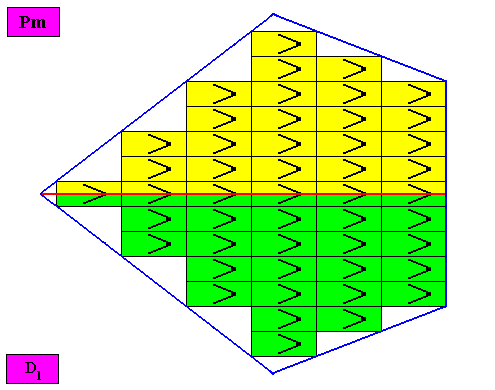
Figure above : A bilateral pentagonal D1 two-dimensional crystal. The case of t w o congruent (symmetric) antimers (green, yellow). Note the correspondence between the morphology of the (microscopic) motif (as translation-free residue) and the arrangement of the (macroscopic) antimers of the crystal. In this way the promorph, and in particular the number of antimers is based on the morphology of the translation-free residue of the crystal. This residue is explicitly given in the form of a D1 motif (black) inside each rectangular building block. It is -- or represents -- an atomic configuration such that two antimers (related to each other by a reflection) can be distinguished in it. The crystal is non-eupromorphic because its intrinsic shape suggests five antimers, while in fact there are only two.
Removing the lattice connection lines and the motifs, results in a macroscopic view of the crystal :
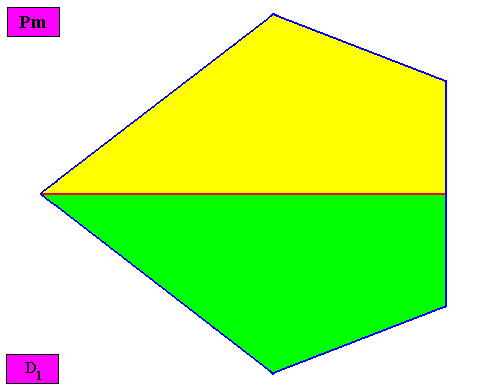
Figure above : Macroscopic view of the bilateral pentagonal D1 two-dimensional crystal of the previous figure, with two congruent (symmetric) antimers (green, yellow).
The promorph of the above bilateral non-eupromorphic crystal is (as two-dimensional analogue) belonging to the Allopola Zygopleura eudipleura. This promorph is depicted in the next Figure.
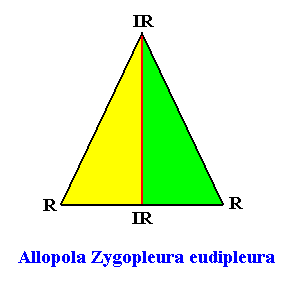
Figure above : The promorph of the bilateral pentagonal D1 crystal with two antimers. It is an isosceles triangle (half a rhombus) and as such the two-dimensional analogue of the isosceles pyramid (half a rhombic pyramid), which represents the promorph of corresponding three-dimensional crystals or other objects. Note the difference in shape between this promorph (bilateral trigon) and that of the crystal (bilateral pentagon) of which it is the promorph. Radial (R) and interradial (IR) directions are indicated.
Five antimers.
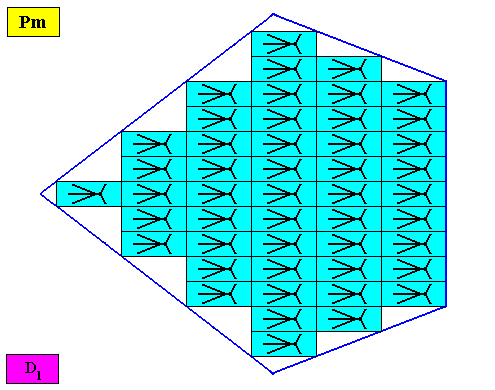
Figure above : A bilateral pentagonal two-dimensional D1 crystal. Its D1 motifs (black) have five symmetrically arranged antimers. Microscopic view.
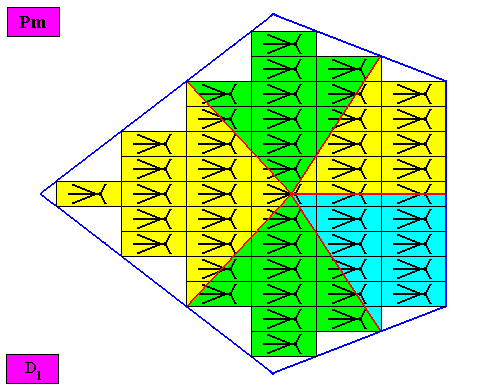
Figure above : The bilateral pentagonal D1 two-dimensional crystal of the previous Figure. The case of f i v e similar antimers (green, yellow, blue). Note the correspondence between the morphology of the (microscopic) motif (as translation-free residue of the crystal) and the arrangement of the (macroscopic) antimers of the crystal. In this way the promorph, and in particular the number of antimers, is based on the morphology of the translation-free residue of the crystal. This residue is explicitly given in the form of a D1 motif (black) inside each rectangular building block. It is -- or represents -- an atomic configuration such that five similar antimers can be distinguished in it. The crystal is eupromorphic because its intrinsic shape suggests five antimers, which are indeed present.
Removing the lattice connection lines and the motifs, results in a macroscopic view of the crystal :
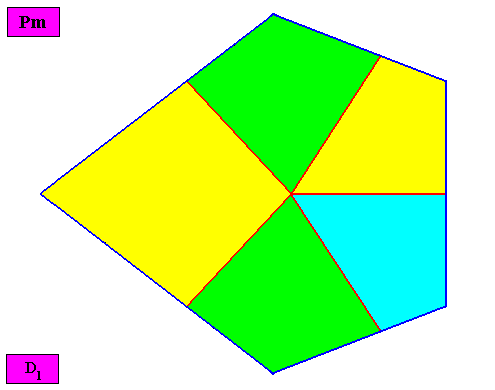
Figure above : Macroscopic view of the bilateral pentagonal D1 two-dimensional crystal of the previous Figure, with five symmetrically arranged antimers (green, yellow, blue).
The next two Figures present another possible configuration of the five (macroscopically conceived) antimers :
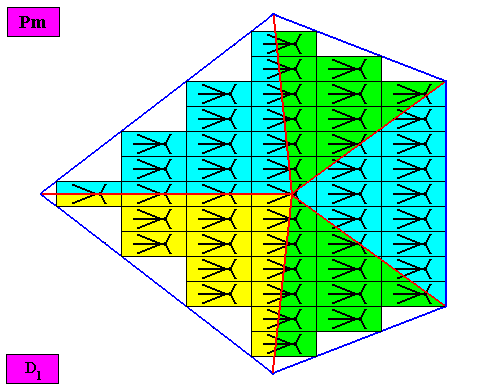
Figure above : Bilateral pentagonal D1 two-dimensional crystal. Another possible case of f i v e similar antimers (green, yellow, blue).
Removing the lattice connection lines and the motifs, results in a macroscopic view of this crystal :
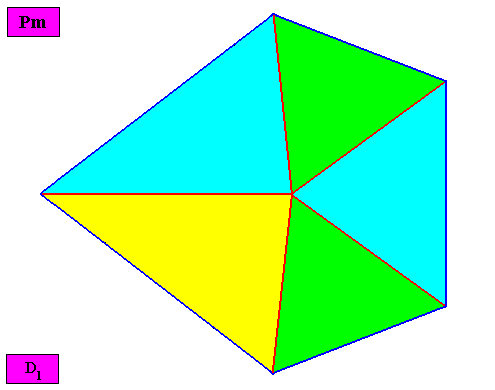
Figure above : Macroscopic view of the bilateral pentagonal D1 two-dimensional crystal of the previous Figure, with five symmetrically arranged antimers (green, yellow, blue).
The promorph of the bilateral crystal is (as two-dimensional analogue) belonging to the Allopola Amphipleura pentamphipleura (Allopola pentamphipleura) and is depicted in the next Figure.
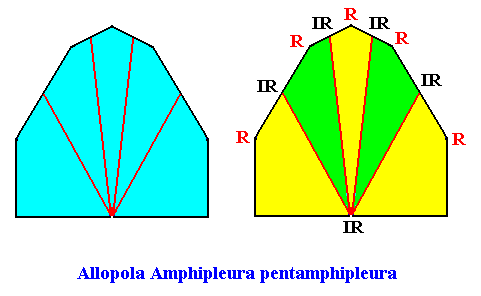
Figure above : The promorph of the bilateral pentagonal D1 crystal with five similar antimers (previous Figures). It is half a ten-fold amphitect polygon and as such the two-dimensional analogue of half a ten-fold amphitect pyramid which is the promorph of corresponding three-dimensional crystals or other objects.
Three antimers.
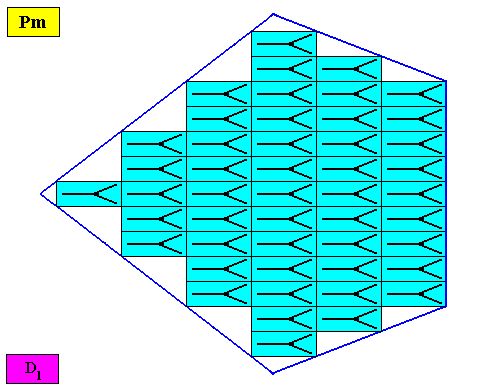
Figure above : A bilateral pentagonal two-dimensional D1 crystal. Its D1 motifs (black) have three symmetrically arranged antimers. Microscopic view.
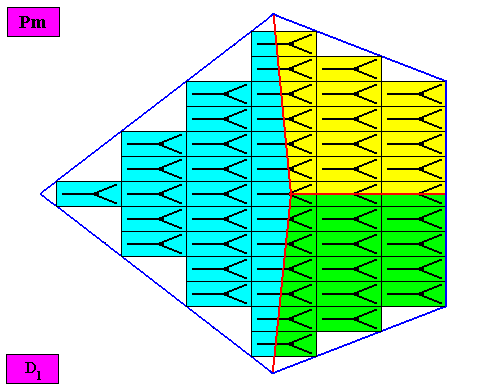
Figure above : The bilateral pentagonal D1 two-dimensional crystal of the previous Figure. The case of t h r e e similar antimers (green, yellow, blue). Note the correspondence between the morphology of the (microscopic) motif (as translation-free residue of the crystal) and the arrangement of the (macroscopic) antimers of the crystal. In this way the promorph, and in particular the number of antimers, is based on the morphology of the translation-free residue of the crystal. This residue is explicitly given in the form of a D1 motif (black) inside each rectangular building block. It is -- or represents -- an atomic configuration such that three similar antimers can be distinguished in it. The crystal is non-eupromorphic because its intrinsic shape suggests five antimers, while only three are present.
Removing the lattice connection lines and the motifs, results in a macroscopic view of the crystal :
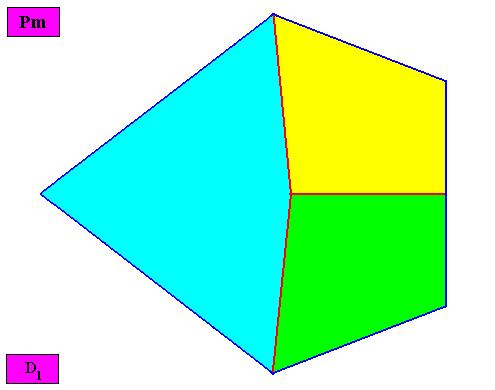
Figure above : Macroscopic view of the bilateral pentagonal D1 two-dimensional crystal of the previous Figure, with three symmetrically arranged antimers (green, yellow, blue).
The promorph of the bilateral crystal is (as two-dimensional analogue) belonging to the Allopola Amphipleura triamphipleura (Allopola triamphipleura) and is depicted in the next Figure.
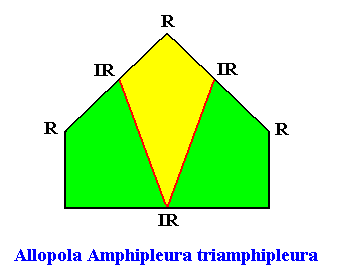
Figure above : The promorph of the bilateral pentagonal D1 crystal with three similar antimers (previous Figures). It is half a six-fold amphitect polygon and as such the two-dimensional analogue of half a six-fold amphitect pyramid which is the promorph of corresponding three-dimensional crystals or other objects.
In the next document we will discuss the tenth crystal shape of our list (as given in Part XVI ) , viz. the regular gyroid octagon, with respect to intrinsic symmetry and promorph in holomorphic two-dimensional crystals having this shape intrinsically.
e-mail : 
To continue click HERE for further study of the Theory of Layers, Part XXV.